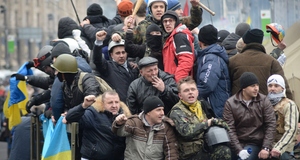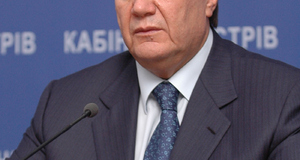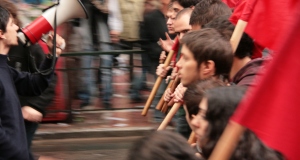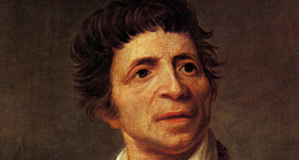What is “revolution”? Can the Maidan movement in Ukraine, which led to the ousting of Viktor Yanukovych in February 2014, be called a revolution? If so, what are the implications of calling the Maidan movement a revolution? While a “war of narratives,” as well as a civil war, is being fought over the legacy of Maidan and the future of Ukraine, this paper tackles these pressing questions by constructing a narrative of the events which unfolded in Ukraine between November 21st, 2013 and March 1st, 2014. This narrative is analyzed in four stages: revolutionary onset, popularization, radicalization, and revolutionary ousting. I argue that the stages of the Maidan movement in Ukraine cannot be considered in isolation, but rather must be considered as a cumulative and dynamic process, which, taken together, constitute a revolution.
The images from Kyiv’s Independence Square—of protesters guarding their barricades against columns of riot police amidst snow and ice and thick black smoke rising from burning tires—dominated the international press during the winter months of 2013-14. There is much disagreement, however, as to whether the events which unfolded in Ukraine, culminating in the ousting of President Yanukovych in late February 2014, are to be considered a popular revolution or not.
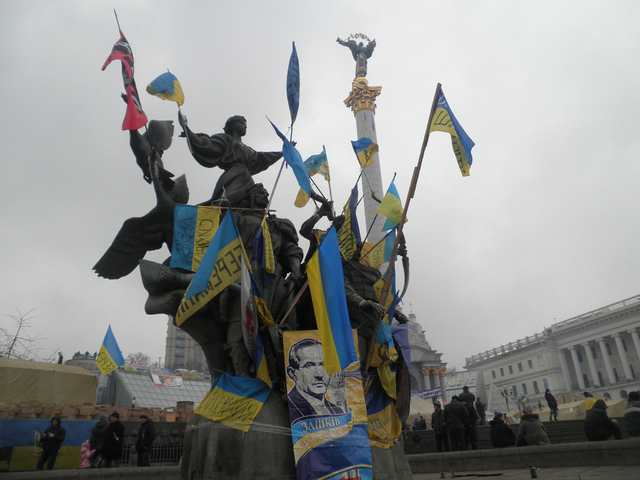
Photo: Jose Luis Orihuela CC-2
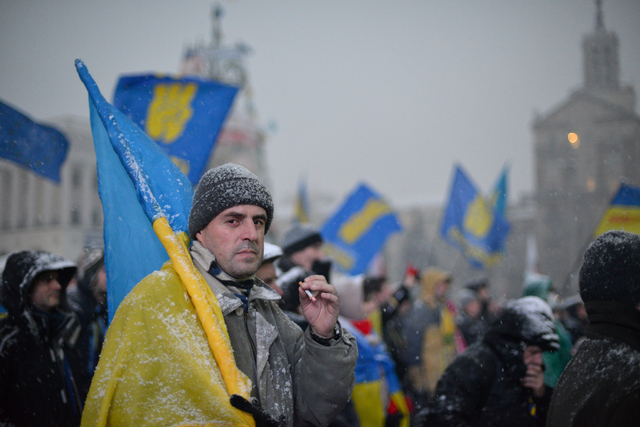
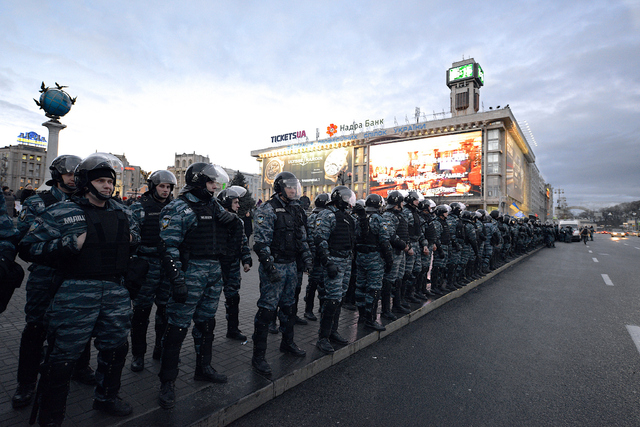
Photos: Ivan Bandura CC-2
A “war of narratives” is effectively being fought over the collective memory of Ukraine’s Maidan and its consequent legacy. This paper seeks to contribute to the debate by providing greater empirical and conceptual depth to the matter, and hopefully disarming those arguments that act only to polarize the debate. The paper begins with a brief discussion of the origin and meaning of the term “revolution” and is then divided into four sections, each delineating a stage in Ukraine’s revolutionary process. The individual sections begin with a chronological narrative of the events in that stage, which is complemented by a conceptual analysis of a specific and determining issue present in that stage.
The first stage is termed the “revolutionary onset,” which lasts from 21 November 2013 to 1 December 2013. The subsequent analysis considers the historical context of EuroMaidan in Ukraine, as well as the theoretical causation of revolution. The second stage of the revolutionary process is termed “popularization,” and lasts from 1 December 2013 to 16 January 2014. The subsequent conceptual analysis centres on the notion of Maidan as a public space for action.
The third stage is the “radicalization” of Maidan, which lasts from 16 December 2014 to 21 February 2014. In this section Hannah Arendt is evoked to discuss the relationship between violence and power, and how the use of violence by the regime shifted power into the hands of the people. The final stage of Ukraine’s Winter Revolution is the “revolutionary ousting” of President Yanukovych, and is set between 21 February 2014 and 1 March 2014. The revolutionary process does not end with Russia’s invasion of Crimea on 1 March, but I chose this date as an end point because the revolutionary process changes considerably after this point. Ultimately, this paper argues that the stages of the Maidan movement in Ukraine cannot be considered in isolation, but as a cumulative and dynamic process, which, taken together, constitute a revolution.
Before any such argument is made, the question arises: Why does it matter whether we call the Maidan movement a “revolution”—as opposed to, perhaps, a “civil resistance campaign” or “coup d’état”? The answer to this question lies in the degree of political legitimacy the provisional government that was inaugurated following the ousting of President Yanukovych and his Party of Regions in fact has, domestically and internationally. Russia’s President Vladimir Putin, as a notable example, has labeled the Maidan movement as a “fascist coup d’état” and does not recognize the legitimacy of the new government in Kyiv; consequently (and conveniently for Moscow), neither does Russia recognize the territorial sovereignty of Ukraine.
A revolution, on the other hand, in the modern conception of the term, necessitates popular domestic support and a “radical break from the past,” among other elements that are discussed in this paper. Consequently, a revolution bestows upon the newly inaugurated government a greater degree of political legitimacy than would be the case if it had come to power through a coup d’état. The following discussion considers the concept of “revolution” in history, before analyzing why the Maidan movement in Ukraine can and must be considered a revolution.
When the term “revolution” first entered the political sphere in 17th-century Europe, it retained its astronomical meaning, describing recurring, cyclical movements, and an irresistible force. “Revolution” was used as a metaphor to intimate a “sweeping dramatic change” in the realms of men; and just as the stars followed their preordained paths in the skies, this dramatic change implied a movement back to a preordained order. The “Glorious Revolution” of 1688, the event through which paradoxically the term found its definite place in political and historical language, was not thought of as a revolution at all, but as a restoration of monarchical power to its former righteousness.
Essentially, the premodern understanding of revolution made no intimation of novelty and self-conscious agents; it was a cyclical and irresistible process—a “reversal of fortune”—that was experienced as a fact, rather than lived as an act. Nothing could be farther removed from the original meaning of the word “revolution” than the idea with which all revolutionary actors have been possessed and obsessed, namely, that they are agents in a process which spells the definite end of an old order and brings about the birth of a new world.
The modern concept of revolution, inextricably tied with the notion that the course of history suddenly begins anew—that an entirely new story is about to unfold—was unknown prior to the two great revolutions at the end of the eighteenth century: the American and the French Revolutions. Hannah Arendt, in her essay On Revolution, writes:
If we want to learn what revolution is—its general implications for man as a political being, its political significance for the world we live in, its role in modern history—we must turn to those historical moments when revolution made its full appearance, assumed a kind of definite shape, and began to cast its spell over the minds of men…
It was in particular the novel ideas and impulses of the French Revolution in 1789 which gave a profoundly new meaning to the notion of revolution, a notion that from then on communicated the possibility of a radical break with the past achieved by the conscious will of human actors. This allegiance between revolution, human agency, and novelty represented an inaugural moment for a drama of change and transformation projected indefinitely into the future. If we consider the famous revolutionary triad of 1789—liberty, equality, fraternity—as the basic point of departure for the three most powerful ideologies of the modern word—liberalism, socialism, nationalism—then every revolution since the French Revolution has carried forth its tradition.
Jaroslav Krejci’s Great Revolutions Compared: The Outline of a Theory provides a useful conceptual framework with which to study revolution. Krejci observes that, as historians, we should not consider revolution to be a single event, but rather a protracted period of turbulent, dramatic events, which may be better styled as a “revolutionary process.” However, the notion of revolution, or revolutionary process, continues to escape simple definition. Hence, the best a conceptual discussion on revolution can do—without taking a reductionist stance—is to consider those events in history that qualify as “sweeping dramatic changes” and search for common variables.
Among others, these include the role of novelty, human agency, necessity, ideology, popularity, rhetoric, power, violence, and freedom. Since we understand revolution not as a single event but as a process, it follows that all its characteristic elements do not need to materialize at once or in a particular stage of that process. The discussion that follows on Ukraine from 21 November 2013 to 1 March 2014 will analyze the variables that commonly appear in revolutionary processes and, in so doing, establish why the crisis in Ukraine was a revolution.
“No Deal,” read the news headlines in Ukraine on 21 November 2013—the austerity of two words marked the onset of a revolutionary process that would set Kyiv’s Maidan Nezalezhnosti (Independence Square) ablaze for the ensuing four months of winter. On 21 November the Ukrainian government, headed by President Viktor Yanukovych (2010-14), Prime Minister Mykoly Azarov (2012-14), and the Party of Regions, rejected a “landmark” association agreement with the European Union (EU).
That same evening a spontaneous, social media-organized demonstration of 2,000 people, mostly students, came to Maidan carrying Ukrainian and EU flags in protest. The leaders of the three opposition parties in parliament—Arseniy Yatseniuk of Batkivshchyna (Fatherland), Vitali Klitschko of the Ukrainian Democratic Alliance for Reforms (UDAR), and Oleh Tiahnybok of Svoboda (Freedom)—joined the rally and called for a larger one to be held on Sunday. The mass demonstration on Sunday 24 November against the government’s decision not to sign the EU association agreement brought more than 100,000 people to Maidan Nezalezhnosti; this was the largest demonstration in Ukraine since the “Orange Revolution” in 2005.
The peaceful protest movement that began on 21 November 2013 became known as “EuroMaidan,” following the popular Twitter hashtag. In its inception, EuroMaidan (which translates as “EuroSquare”) was experienced and understood as a continuation of the Orange Revolution. The initial demands of EuroMaidan were policy-motivated and limited in their scope: the movement sought to convince President Yanukovych to change course and agree to sign the EU association agreement at the summit in Vilnius, Lithuania, which ended on 29 November.
When the deadline passed and no deal was signed, the organizers of EuroMaidan and the leaders of the political opposition called on the people to focus their efforts in peacefully removing the government from power in the 2015 presidential elections. The mass demonstration on Sunday 1 December was intended to be the concluding chapter of EuroMaidan. The unexpected events in the early hours of 30 November proved otherwise; in fact, Ukraine was just reading the introduction to the story of Maidan—the first stage to a popular revolution.
At 04:00 on 30 November, Berkut riot police “brutally” removed the several hundred peaceful protesters who remained on Maidan Nezalezhnosti, critically injuring 36 men and women, most of them students. The incident sparked popular outrage amongst Ukrainians against the Yanukovych-Azarov regime. In Lviv some 20,000 people protested that evening, and in Kyiv 10,000 people came out, defying the government’s latest ban on demonstrations in public squares. “Ukraine, wake up!” the protesters shouted, and their calls were answered on Sunday 1 December by 350,000 voices that came to rally on Maidan.
One protester preceptively expressed the sentiment of that evening: “I am here because what happened two nights ago was brutal. They have beaten not only those at Maidan, but every one of us…. We will be slaves, and this is not just a romantic comparison.” The EU association agreement became a secondary concern, i.e. a means to an end, while this end now sought to hold Ukraine’s authorities accountable, stop the incessant corruption, and correct the arbitrary and dysfunctional rule of law. The people ultimately came to the streets to express their desire to “change life in Ukraine.”
The mass demonstrations on 1 December instilled EuroMaidan with a sense of necessity—a sense of “now or never.” A Ukrainian journalist participating at the rally said: “I’m sure that we should be here to the end, otherwise we’ll lose Ukraine again like we did many times already. There’s no other way.” Later that evening, the demonstration turned violent when 20,000 protesters tried to occupy the Presidential Office and were pushed back by riot police with truncheons, tear gas, and flash grenades. The protestors responded in kind by throwing rocks, fireworks, and Molotov cocktails. Barricades were erected around Maidan, and members of the far-right party Svoboda seized the City Hall and Trade Union buildings, turning them into “revolutionary headquarters.”
The opposition parties Batkivshchyna and UDAR established “headquarters of national resistance” across Ukraine. On 1 December EuroMaidan became an alternative power structure to the government, and would now enter the second stage in its revolutionary process: popularization. In order to understand why an incident of police brutality transformed a policy-oriented protest into the onset of a popular revolution—why there was “no other way”—we need first to consider the underlying historical context of EuroMaidan in Ukraine, and thereby, the causation of revolution.
Krejci’s analysis on the causation of revolutions in Great Revolutions Compared examines the patterns of contradictions which played an essential role in the unfolding of past revolutions. Krejci does so without attempting to schematize his etiology, i.e. the structure of causation he presents is eclectic. Krejci effectively brings together six theories and embarks to explore the degrees to which these theories are able to explain his “empirical data.” The theories that are considered are: Weber’s disproportion between wealth and power; Marx’s contradiction between productive forces and modes of production as reflected in the class struggle; the Aristotelian contradiction arising from differing conceptions of justice; the Tocquevillian sense of relative deprivation between expectations and achievements; the Paretian contradiction between the elites loyal to an incumbent regime and those which for reasons of interest or ideology wish to overthrow it; and the Khaldunian disproportion between the fighting spirit of those inspired by a new faith and the less dynamic stance of those defending an old order. When applied to the context of Ukraine, these theories (in particular the Tocquevillian disproportion) go far in explaining how EuroMaidan developed into a popular revolution.
Before a conceptual analysis can be applied, however, the structural context of Ukraine’s recent history must briefly be considered. Ukraine declared its independence from the Soviet Union in August 1991. Despite popular approval, independence arrived without a major popular movement to shape it. The process of nation-building in Ukraine—a country of diverse peoples and histories, situated between Russia and an expanding European community—has defined the country’s political, economic, social, and cultural life since independence and is still in process. The chaos of the 1990s witnessed a select few individuals monopolize the economic, and hence, political capital of the country.
The Orange Revolution between November 2004 and January 2005 briefly demonstrated that there existed an active civil society in Ukraine which could hold the elites accountable. The election of the pro-European candidate Viktor Yushchenko in January 2005 instilled hope that the situation in the country would improve. Instead, the Yushchenko-Tymoshenko government was marred by political infighting, and in February 2010 the candidate who had been defeated in the Orange Revolution, Viktor Yanukovych, was elected as president.
Between Yanukovych’s election and the onset of EuroMaidan, Ukraine’s democracy was unravelled, the rule of law undermined, and the economy severely mismanaged. In late 2013 Ukraine faced bankruptcy and President Yanukovych and Prime Minister Azarov decided it was in their interests to ask the Russian Federation for financial support rather than the EU or IMF. On 21 November the Yanukovych-Azarov government announced that Ukraine would not be signing the association agreement with the EU that was scheduled to be signed on 28 November, and which had been on the negotiating table for several years.
The onset of the EuroMaidan protests can initially be explained by the Tocquevillian disproportion, i.e. “a sudden widening of the gap between expectation and gratification when it is perceived that the governing regime is either responsible for, or incapable of, dealing with this intolerable situation.” Broadly speaking, integration with the European Union represented an assurance that there would be the rule of law, a reduction in corruption, and economic prosperity—essentially, a future. However, the “frustrated expectations” of a great many Ukrainians, expressed loudest by the younger generation, could not in itself cause a popular revolution. According to Krejci:
The combustible material, so to speak, has to be further prepared before ignition takes place. A sufficient number of people have to be deeply disturbed by the development. Their perception of the causes of their trouble may vary; individuals or groups may even take opposing views, but they are united by their discontent with, or hatred of, the government.
The incidence of police brutality on 30 November, in which hundreds of peaceful protesters were beaten at night, ignited popular outrage amongst Ukrainians. As intimated by the Aristotelian contradiction, the people needed to consider their plight not only as unbearable, but also as “unjust in terms of a value system which differed from that practiced by the people in power.” The blatant manifestation of injustice on 30 November, combined with the sudden rejection of a European future just days before, unified the Ukrainian people in their discontent with the Yanukovych-Azarov regime.Continued on Next Page »
Secondary Sources
- Arendt, Hannah. On Revolution. New York: Penguin Books, 2006.
- Arendt, Hannah. On Violence. New York: Harvest Book, 1970.
- Baker, Keith M. Inventing the French Revolution. Cambridge: Cambridge University Press, 1990.
- D'Anieri, Paul. Understanding Ukrainian Politics: Power, Politics, and Institutional Design. Armonk, N.Y.: M.E. Sharpe, 2007.
- De Tocqueville, Alexis. The Old Regime and the French Revolution. trans. Stuart Gilbert. London: Anchor Books, 1983.
- Hunt, Lynn. Politics, Culture, and Class in the French Revolution. Berkeley: University of California Press, 2004.
- Krejci, Jaroslav. Great Revolutions Compared: The Outline of a Theory. New York: Harvester Wheatsheaf, 1994.
- Okey, Robin. The Demise of Communist East Europe: 1989 in Context. London: Hodder Arnold, 2004.
- Rachum, Ilan. “The Meaning of “Revolution” in the English Revolution, 1648-1660.” Journal of the History of Ideas, vol. 56 (1995): 195-215.
- White, Hayden. “The Value of Narrativity in the Representation of Reality.” Critical Inquiry, vol. 7 (1980): 5-27.
- Wilson, Andrew. The Ukrainians: Unexpected Nation. New Haven, Conn: Yale University Press, 2009.
- Yekelchyk, Serhy. Ukraine: Birth of a Modern Nation. Oxford: Oxford University Press, 2007.
Media Sources
Documentaries
- “Crimea: Unmasking Revolution,” Russia Today, March 7, 2014, accessed April 12, 2014, http://rt.com/shows/documentary/ukraine-%E2%80%8Bcrimea-unmasking-revolution-438/.
- “Kiev Burning,” Vice Media, February 20, 2014, accessed March 23, 2014, http://www.vice.com/vice-news/ukraine-burning.
- “Kiev: Masks of Revolution,” Russia Today, February 19, 2014, accessed March 22, 2014, http://rt.com/shows/documentary/kiev-masks-of-revolution-388/.
- “Revolution of Dignity,” ICTV, March 8, 2014, accessed March 9, 2014, https://www.kyivpost.com/content/ukraine/ictvs-documentary-revolution-of-dignity-now-has-english-language-subtitles-338913.html.
- “Ukraine: State of Chaos,” Aljazeera, 2012, (update January 15, 2014), accessed March 23, 2014, http://www.aljazeera.com/programmes/witness/2012/11/2012112261029228352.html.
Endnotes
1.) The author is conscious of the fact that this is a contentious position to hold, for it rests on an understanding of “political legitimacy”—essentially democratic, i.e. the government is popular amongst its electorate—that is not definite and, therefore, not universally understood in such terms.
2.) Ilan Rachum, “The Meaning of “Revolution” in the English Revolution, 1648-1660,” Journal of the History of Ideas, vol. 56 (1995): p. 214.
3.) Ibid, p. 211.
4.) Keith M. Baker, Inventing the French Revolution (Cambridge: Cambridge University Press, 1990), p. 206.
5.) Hannah Arendt, On Revolution (New York: Penguin Books, 2006), p. 18.
6.) Ibid, p. 34.
7.) The displacement of the narrative from the political to the social, from the vicissitudes of thrones and governments to the progress of civil society, lay at the heart of Enlightenment thinking. Baker, Inventing the French Revolution, p. 212.
8.) Robin Okey, The Demise of Communist East Europe: 1989 in Context (London: Hodder Arnold, 2004), p. viii.
9.) While I disagree with Krejci’s attempt to develop a general revolutionary theory, his work does provide a number of valuable insights.
10.) Krejci suggests that revolution against sovereign authorities in the home country can be called “vertical revolution,” and revolution against sovereign authorities seated in another country “horizontal revolution.” Krejci suggests that only revolution in which action is initiated from below can be considered as a revolution in the proper sense of the word. Action from above and from the side can be styled as revolutions only in a broader meaning. Revolutions that are both vertical and horizontal, or started both from below and from above, may be described as “hybrid revolutions.” Jaroslav Krejci, Great Revolutions Compared: The Outline of a Theory (New York: Harvester Wheatsheaf, 1994), pp. 7-11.
11.) Ibid, p. 6.
12.) I constructed the narrative of the EuroMaidan Revolution, from 21 November 2013 to 1 March 2014, using a broad selection of media sources. The fact that these events are so current, and that the author does not speak Ukrainian or Russian, necessitated this primary focus on media sources. The greatest part of information was taken from the Kyiv Post, Russia Today, and EuroNews, all of which provided relatively objective coverage of the events in Ukraine. Kyiv Post has a slight European bias in its coverage, which is effectively complemented in the author’s research by using RT, which has a Russian bias. Among what is broadly defined as “Western” media, EuroNews provides a balanced coverage of the Ukraine crisis. Yet, considering the “haze of propaganda” to which the Maidan revolution has been subjected, i.e. a war of narratives, it becomes inherently complicated to construct a narrative that is neutral and informative, while still coherent and compelling. Nevertheless, I sought to do so to the best of his abilities, notably in fact-checking information by diversifying sources. A further difficulty in constructing this narrative—in fact, any narrative, is selection, i.e. what to include and what no to. The focus of this paper is on “revolution,” hence, the focus of the narrative is on the revolutionary elements of the events in Ukraine between November 2013 and March 2014. Having said this, the conceptual analysis of the events in Ukraine has been purposefully separated from the narrative so as not to distort the narrative—its coherence, and more importantly, its neutrality. Timothy Snyder, “Ukraine: The Haze of Propaganda,” NY Books, March 1, 2014, accessed March 11, 2014, http://www.nybooks.com/blogs/nyrblog/2014/mar/01/ukraine-haze-propaganda/.
13.) Katya Gorchinskaya, “No Deal,” Kyiv Post, Nov. 21, 2014, accessed March 9, 2014, http://www.kyivpost.com/content/ukraine/no-deal-2-332280.html; Anastasia Forina and Oksana Grytsenko, “Nine Years After Start of Orange Revolution, Kyivans Take to Streets in Protest of Scuttled EU Deal,” Kyiv Post, Nov. 22, 2014, accessed March 9, 2014, http://www.kyivpost.com/content/ukraine/nine-years-after-start-of-orange-revolution-kyivans-take-to-streets-in-protest-of-scuttled-eu-deal-332282.html; Katya Gorchinskaya, “Echoes of Orange Revolution: Volunteers Kick into Action for EuroMaidan Protests,” Kyiv Post, Nov. 24, 2013, accessed March 9, 2014, http://www.kyivpost.com/content/ukraine/volunteers-who-run-euromaidan-332400.html.
14.) The rapid appearance and organization of EuroMaidan is primarily an achievement of social networks and online media. The Facebook posts of Mustafa Nayem on 21 November, in which he called on others to go to Independence Square, got more than 1,000 shares in several hours. The official “EuroMaidan” Facebook page became the fastest growing page in Ukraine: between its launch on 21 November and 29 November, it attracted 102,000 subscribers. This suggests that during the first stage of the revolutionary process, the protests attracted primarily Ukraine’s younger and middle-class population. Kateryna Kapliuk, “Role of social media in EuroMaidan movement essential,” Kyiv Post, Dec. 1, 2013, accessed March 9, 2014, http://www.kyivpost.com/content/ukraine/role-of-social-media-in-euromaidan-movement-essential-332749.html.
15.) Katya Gorchinskaya, “Echoes of Orange Revolution: Volunteers Kick into Action for EuroMaidan Protests,” Kyiv Post, Nov. 24, 2013, accessed March 9, 2014, http://www.kyivpost.com/content/ukraine/volunteers-who-run-euromaidan-332400.html. The Orange Revolution, despite its name, was in fact not a revolution. It was a series of mass demonstrations between late-November 2004 and January 2005 that called for a re-run of presidential elections that had, in the first run, been marred by corruption, voter intimidation, and electoral fraud. The Supreme Court approved a new round of elections in which the pro-EU candidate Viktor Yushchenko (who was allied with Yulia Tymoshenko) defeated Viktor Yanukovych. In general, the “Orange Maidan” movement was defined by popular civil action but its scope remained limited to immediate political demands. Paul D’Anieri, Understanding Ukrainian Politics: Power, Politics, and Institutional Design (New York: M.E. Sharpe, 2007), p. 82.
16.) Daryna Shevchenko, “Vox Populi: How should the nation react to police violence against protesters?” Kyiv Post, Nov. 30, 2013, accessed March 9, 2014, http://www.kyivpost.com/content/ukraine/vox-populi-with-daryna-shevchenko-how-should-the-nation-react-to-the-violent-night-events-at-maidan-nezalezhnosti-332711.html.
17.) Sociologists at the Democratic Initiatives Foundation, who questioned 1,037 Ukrainian protesters, concluded that the decision by the Ukrainian authorities to disperse the peaceful demo with force was a big mistake. “When we asked people why they joined the rally, 70 percent said they came because they were angry with the dispersal of the peaceful pro-EU demo on November 30. 54 percent of people said it was the Ukrainian president’s refusal to sign the Association Agreement with the EU, and the third reason for coming to Independence Square is a will to change life in Ukraine,” said sociologist Yulia Ilchuk. “Ukrainian opposition uses polls to bolster cause,” EuroNews, December 12, 2013, accessed April 26, 2014, http://www.euronews.com/2013/12/13/ukrainian-opposition-uses-polls-to-bolster-cause/.
18.) “Police violently break up Independence Square protests at 4 a.m. today; many injuries reported,” Kyiv Post, Nov. 30, 2013, accessed March 9, 2014, http://www.kyivpost.com/content/ukraine/reports-police-forcefully-break-up-protest-site-on-maidan-nezalezhnosti-this-morning-332674.html.
19.) Katya Gorchinskaya and Oksana Grytsenko, “Government admits helplessness, asks for a new deal with Europe,” Kyiv Post, Dec. 2, 2013, accessed March 9, 2014, http://www.kyivpost.com/content/politics/government-admits-helplessness-asks-for-a-new-deal-with-europe-332858.html.
20.) Krejci, Great Revolutions Compared, pp. 31-36.
21.) Ukraine had had a brief spell of independence between 1917 to 1921, before being defeated by the Red Army and becoming a member of the Soviet Union. Andrew Wilson, The Ukrainians: Unexpected Nation (London: Yale University Press, 2009), p. 22.
22.) The revolutionary process of Maidan can be argued to have begun on 1 December 1991, when the 90 percent of Ukrainians voted for independence from the Soviet Union in a national referendum. In this view, the Winter Revolution in Ukraine (2013-2014) was a confirmation of Ukraine’s independence from its powerful eastern neighbour Russia, i.e. a confirmation of Ukraine’s sovereignty. This notion of sovereignty, however, cannot be primarily considered as a rejection of Russia—which is not the case—but as an internal process of nation-building, i.e. drawing national consensus and defining national identity.
23.) The 1990s were a period of economic turmoil in Ukraine: by the end of the decade, the economy had shrunk to one third of its pre-1991 level. Serhy Yekelchyk, Ukraine: Birth of a Modern Nation (Oxford: Oxford University Press, 2007), p. 43.
24.) “Ukraine: State of Chaos,” Aljazeera, 2012, (update January 15, 2014), accessed March 23, 2014, http://www.aljazeera.com/programmes/witness/2012/11/2012112261029228352.html.
25.) “Profile: Ukraine's ousted President Viktor Yanukovych,” BBC News, February 28, 2014, accessed March 23, 2014, http://www.bbc.com/news/world-europe-25182830.
26.) EU or IMF conditions on loans would not have favoured President Yanukovych’s increasingly authoritarian leadership. What is more, Russia’s President Vladimir Putin had ambitions to create a Eurasian Union, and Ukraine could not be both a member of both Putin’s union and the European Union. Peter Leonard, “IMF offers Ukraine up to $18 billion in loans,” Yahoo News, March 27, 2014, accessed April 2, 2014, http://news.yahoo.com/imf-offers-ukraine-18-billion-loans-082715644.html.
27.) Krejci, Great Revolutions Compared, p. 35.
28.) “Ukrainian opposition uses polls to bolster cause,” EuroNews, December 12, 2013, accessed April 26, 2014, http://www.euronews.com/2013/12/13/ukrainian-opposition-uses-polls-to-bolster-cause/.
29.) Krejci, Great Revolutions Compared, p. 35.
30.) Ibid, p. 33.
31.) Katya Gorchinskaya and Oksana Grytsenko, “Government admits helplessness, asks for a new deal with Europe,” Kyiv Post, Dec. 2, 2013, accessed March 9, 2014, http://www.kyivpost.com/content/politics/government-admits-helplessness-asks-for-a-new-deal-with-europe-332858.html.
32.) Arendt, On Revolution, p. 42.
33.) The four largest TV channels in Ukraine, Inter, ICTV, 1+1, and Ukraiina TV, are owned by the country’s oligarchs. The channels thus effectively act as weathervanes for which way the political winds are blowing. If the channels are reporting censored news on EuroMaidan, this means that their owners are are betting their stakes on President Yanukovych. If they are reporting relatively objective news, this suggests that the oligarchs see the possibility of power shifting and are watching and waiting to see what happens. All the major channels, except for ICTV, reported objectively on the mass demonstration on 1 December, Inter even encouraged viewers to attend the rally. However, by mid December the news again became visibly censored, suggesting that the oligarchs perceived the momentum to be with the Yanukovych-Azarov regime, not with EuroMaidan. Mary Mycio, “News analysis: A television news breakthrough,” Kyiv Post, Dec. 7, 2013, accessed March 9, 2014, http://www.kyivpost.com/content/ukraine/news-analysis-a-television-news-breakthrough-333200.html.
34.) A survey of protesters conducted on the 7 and 8 December found that 92% of those who came to Kiev from across Ukraine came on their own initiative, and 8% came as part of a political party or civil society organization. In terms of cause, 70% said they came to protest the police brutality of 30 November, and 54% to protest in support of the EU Association Agreement signing. Among their demands, 82% wanted detained protesters freed, 80% wanted the government to resign, and 75% want president Yanukovych to resign and for snap elections. “EuroMaidan rallies in Ukraine - Dec.9,” Kyiv Post, Dec. 10, 2013, accessed March 9, 2014, http://www.kyivpost.com/content/ukraine/euromaidan-rallies-in-ukraine-live-updates-332341.html.
35.) Olga Rudenko, “Another Sunday, another big rally,” Kyiv Post, Dec. 15, 2013, accessed March 9, 2014, http://www.kyivpost.com/content/ukraine/another-sunday-another-big-rally-333740.html.
36.) EuroMaidan kept its resolve, captured here by one plain-spoken protester on 15 December: “[The authorities] don’t listen to us at all. So we must stay here until they start listening.” Ibid.
37.) Daryna Shevchenko and Olena Goncharova, “Chief prosecutor Pshonka gives his version of Nov. 30-Dec. 1 EuroMaidan violence,” Kyiv Post, Dec. 20, 2013, accessed March 9, 2014, http://www.kyivpost.com/content/ukraine/chief-prosecutor-pshonka-gives-his-version-of-nov-30-dec-1-euromaidan-violence-334043.html.
38.) On 25 December the journalist and activist Tetiana Chornovol, who was investigating the luxurious homes of top Ukrainian officials, was brutally attacked on her way home by a group of men. Ibid.
39.) Bandera is a controversial historical figure who collaborated with the Nazi’s during the Second World War and is considered by many Ukrainians, especially in the east, with contempt.
40.) Democratic Initiatives Foundation, December 8, 2013, accessed, April 12, 2014, http://www.dif.org.ua/en/events/gvkrlgkaeths.htm.
41.) Pro-government rallies that did occur were no larger than 20,000, and there is ample evidence that many pro-government protesters were paid for their services. Daryna Shevchenko and Olena Goncharova, “Chief prosecutor Pshonka gives his version of Nov. 30-Dec. 1 EuroMaidan violence,” Kyiv Post, Dec. 20, 2013, accessed March 9, 2014, http://www.kyivpost.com/content/ukraine/chief-prosecutor-pshonka-gives-his-version-of-nov-30-dec-1-euromaidan-violence-334043.html.
42.) President Yanukovych had only suspended three lower level officials in response to the 30 November police assaults; meanwhile, dozens of activists remained in prison. Ibid.
43.) On 9 January government hired thugs, “titushki,” violently broke up a EuroMaidan forum in Kharkiv, the second largest city in Ukraine. Oksana Grytsenko, “Smashed windows, tear gas accompany EuroMaidan forum in Kharkiv,” Kyiv Post, Jan. 11, 2014, accessed March 9, 2014, http://www.kyivpost.com/content/ukraine/smashed-windows-tear-gas-accompany-euromaidan-forum-in-kharkiv-334870.html.
44.) On 5 January EuroMaidan activists called for a boycott of Inter TV, Ukraine’s most viewed channel, due to increasingly biased coverage. The statement reads: “During the recent weeks, the [Inter] channel’s editorial policy has undergone catastrophic changes. Without any objective reasons, the issue of Maidan has disappeared from the news. If covered, it does so in such a distorted way that it has nothing to do with the reality.” On 24 December a longtime associate of oligarch Dmytro Firtash took over management at Inter TV. In response, three executives resigned. Vlad Lavrov, “EuroMaidan activists call for boycott of Inter TV channel,” Kyiv Post, Jan. 5, 2014, accessed March 9, 2014, http://www.kyivpost.com/content/ukraine/euromaidan-activists-call-for-boycott-of-inter-tv-channel-334683.html.
45.) Katya Gorchinskaya, “Lyovochkin resigns over draconian anti-democratic laws; others expected to quit soon,” Kyiv Post, Jan. 17, 2014, accessed March 9, 2014, http://www.kyivpost.com/content/politics/lyovochkin-resigns-over-draconian-anti-democratic-laws-others-expected-to-quit-soon-335152.html.
46.) “Revolution of Dignity,” ICTV, March 8, 2014, accessed March 9, 2014, https://www.kyivpost.com/content/ukraine/ictvs-documentary-revolution-of-dignity-now-has-english-language-subtitles-338913.html.
47.) Olena Goncharova, “A month later, EuroMaidan beat goes on,” Kyiv Post, Dec. 21, 2013, accessed March 9, 2014, http://www.kyivpost.com/content/ukraine/a-month-later-euromaidan-beat-goes-on-334112.html.
48.) Lynn Hunt, Politics, Culture, and Class in the French Revolution, (Berkeley: University of California Press, 2004), p. 27.
49.) Hunt, Politics, Culture, and Class, p. 24.
50.) Timothy Snyder, “Fascism, Russia, and Ukraine,” NY Books, February 19, 2014, accessed March 11, 2014, http://www.nybooks.com/articles/archives/2014/mar/20/fascism-russia-and-ukraine/?insrc=rel.
51.) It is symbolic that it was a tradition at EuroMaidan since the movement began on 21 November 2013 to sing the Ukrainian national anthem almost every hour. Does this suggest that Ukraine’s independence is through Europe? Olena Goncharova, “A month later, EuroMaidan beat goes on,” Kyiv Post, Dec. 21, 2013, accessed March 9, 2014, http://www.kyivpost.com/content/ukraine/a-month-later-euromaidan-beat-goes-on-334112.html.
52.) An impressive burst of creativity took place online. Memes and photo-shopped pictures making fun of Ukrainian politicians and police officers were shared by everyone sympathetic to Maidan. Andrey Zelinsky, an art director from Kyiv, was the author of many of these memes. The first one he made depicted a shadowy Kyiv and two riot policemen beating a protester, reading “Welcome Ukraine.” Zelinskyi explained: “I drew that the day I woke up and realized that I live in a police state.” Daryna Shevchenko, “Smart and funny EuroMaidan posters,” Kyiv Post, Dec. 25, 2013, accessed March 9, 2014, http://www.kyivpost.com/content/lifestyle/smart-and-funny-euromaidan-posters-334231.html.
53.) “Revolution of Dignity,” ICTV, March 8, 2014, accessed March 9, 2014, https://www.kyivpost.com/content/ukraine/ictvs-documentary-revolution-of-dignity-now-has-english-language-subtitles-338913.html.
54.) Arendt, On Revolution, p. xv.
55.) The laws introduced 10-year jail terms for blockading government buildings; hefty fines and prison terms for protesters who wear face masks and helmets; fines and prison terms for unauthorized installation of and provision of facilities or equipment for tents, stages or amplifiers in public places; and driving bans for people who form convoys of more than five cars. Also approved was legislation to easier strip members of parliament of immunity; the identification of members of non-government organizations funded by foreign governments or foundations as "foreign agents"; 2-year jail terms for defamation spread through social media; 1-year jail terms of corrective labour for slandering government officials; mandatory registration for internet-based media and prepaid mobile phone services purchasers. "Ukraine's parliament passes tough anti-protest laws,” Financial Times, January 16, 2014, accessed March 22, 2014, http://www.ft.com/intl/cms/s/0/e9367e64-7ebc-11e3-a2a7-00144feabdc0.html#axzz30JzfM3V4.
56.) The law caused the resignation of several top government staff members, including Serhiy Lyovochkin, President Yanukovych’s long-time chief of staff, Denys Ivanesko, head of public information, Darka Chepak, press secretary, and Andriy Yermolaev, a political advisor to the president. Katya Gorchinskaya, “Lyovochkin resigns over draconian anti-democratic laws; others expected to quit soon,” Kyiv Post, Jan. 17, 2014, accessed March 9, 2014, http://www.kyivpost.com/content/politics/lyovochkin-resigns-over-draconian-anti-democratic-laws-others-expected-to-quit-soon-335152.html.
57.) The Traditional chants of “Bandits, get out!” and “Glory to the Ukraine!” had become tiresome. “EuroMaidan ralles in Ukraine (Jan. 20 updates),” Kyiv Post, Jan. 21, 2014, accessed March 9, 2014, http://www.kyivpost.com/content/ukraine/euromaidan-ralles-in-ukraine-jan-20-updates-335302.html.
58.) Ibid.
59.) “Kiev Burning,” Vice Media, February 20, 2014, accessed March 23, 2014, http://www.vice.com/vice-news/ukraine-burning.
60.) On 21 January Yuriy Verbytsky, a protester abducted the day before along with activist Ihor Lutsenko, was been found dead. At a press conference on 24 January, Lutsenko said: “I am not leaving until we win, no matter what happens.” Daryna Shevchenko, “Activist tortured by police in video returns to EuroMaidan, talks to journalists,” Kyiv Post, Jan. 24, 2014, accessed March 9, 2014, http://www.kyivpost.com/content/ukraine/man-tortured-by-police-in-video-returns-to-euromaidan-talks-to-journalists-335545.html.
In the eastern regions of Dnipropetrovsk and Zaporizhya, peaceful protesters were assaulted on 27 January by “titushki,” government hired thugs. Sergey Gorobets, who attended the protest, was perplexed: “I just don’t understand how hooligans can attack people and be under police protection while doing it. After that, how can a dialogue happen?” Olga Rudenko, “Police join forces with thugs to violently suppress protests in eastern Ukraine,” Kyiv Post, Jan. 27, 2014, accessed March 9, 2014, http://www.kyivpost.com/content/ukraine/police-joins-forces-with-thugs-to-violently-suppress-protests-in-eastern-ukraine-335688.html.
61.) Tiahnybok, leader of Svoboda Party, said: “This is the third round of negotiations, and we have felt a real change in mood….people are taking power into their hands.” Katya Gorchinskaya and Oksana Grytsenko, “Opposition rejects Yanukovych offer, but willing to talk more,” Kyiv Post, Jan. 26, 2014, accessed March 9, 2014, http://www.kyivpost.com/content/ukraine/yanukovych-offers-prime-ministers-job-to-yatseniuk-makes-other-concessions-335591.html.
62.) Yanukovych offered the Prime Minister position to Yatseniuk, who refused. “Yanukovych accepts Azarov's resignation; other disputes remain,” Kyiv Post, Jan. 28, 2014, accessed March 9, 2014, http://www.kyivpost.com/content/politics/azarov-resigns-as-parliament-session-gets-under-way-335719.html.
63.) President Yanukovych no longer felt the supporting shoulder of Russia. A number of Russian government-controlled TV channels portrayed Yanukovych as a weak leader, and suggested that federalization and even disintegration of Ukraine was inevitable. This scared Yanukovych and put him off the idea of further compromise. Katya Gorchinskaya, “Russia restarts trade sanctions against Ukraine,” Kyiv Post, Jan. 29, 2014, accessed March 9, 2014, http://www.kyivpost.com/content/ukraine/russia-restarts-trade-sanctions-against-ukraine-335835.html.
64.) The former president Leonid Kravchuk warned parliament that this law would only inflame tension further in Ukraine, which is “on the brink of civil war.” “Kiev Burning,” Vice Media, February 20, 2014, accessed March 23, 2014, http://www.vice.com/vice-news/ukraine-burning.
65.) “Yanukovych accepts Azarov's resignation; other disputes remain,” Kyiv Post, Jan. 28, 2014, accessed March 9, 2014, http://www.kyivpost.com/content/politics/azarov-resigns-as-parliament-session-gets-under-way-335719.html.
66.) Olga Rudenko and Solomiya Zinevych,” EuroMaidan increases security after bomb cripples two protesters,” Kyiv Post, Feb. 7, 2014, accessed March 9, 2014, http://www.kyivpost.com/content/kyiv/euromaidan-increases-security-after-bomb-cripples-two-protesters-336490.html.
67.) The Security Service announced that law enforcement was on heightened alert because of threats of terrorism. Ibid.
68.) “Revolution of Dignity,” ICTV, March 8, 2014, accessed March 9, 2014, https://www.kyivpost.com/content/ukraine/ictvs-documentary-revolution-of-dignity-now-has-english-language-subtitles-338913.html.
[69] Danylyuk also said: “Our actions are not civil resistance to Ukrainian leadership only. We see [the current political crisis in Ukraine] as a Russian invasion and occupation of our country.” Olga Rudenko, “Police join forces with thugs to violently suppress protests in eastern Ukraine,” Kyiv Post, Jan. 27, 2014, accessed March 9, 2014, http://www.kyivpost.com/content/ukraine/police-joins-forces-with-thugs-to-violently-suppress-protests-in-eastern-ukraine-335688.html.
70.) “Everyone here has a strong sense of responsibility for Maidan’s future,” a leader of one self-defence unit said. Tetyana Chornovol, the journalist who was attacked on 25 December, said: “They thought it will end on 30 November, but it didn’t. They gave the order to shoot, torture and arrest, but it didn’t work again. They don’t understand that we are here until the end for our children, for our parents, and just because we are smart.” And Ihor Lutsenko, the activist who was kidnapped and tortured, said: “I understand that they understand nothing about us. They still think we are paid here or we at least get some material benefits. All their torture is without any result: Neither me nor Tetyana Chornovol nor Dmytro Bulatov have stopped. We just walk slower.” “EuroMaidan’s victims include five killed, many injured and missing,” Kyiv Post, Jan. 31, 2014, accessed March 9, 2014, http://www.kyivpost.com/content/ukraine/euromaidans-victims-include-five-killed-many-injured-and-missing-335932.html.
71.) “Revolution of Dignity,” ICTV, March 8, 2014, accessed March 9, 2014, https://www.kyivpost.com/content/ukraine/ictvs-documentary-revolution-of-dignity-now-has-english-language-subtitles-338913.html.
72.) Christopher J. Miller and Katya Gorchinskaya, “Guide To EuroMaidan,” Kyiv Post, Feb. 13, 2014, accessed March 9, 2014, http://www.kyivpost.com/content/ukraine/guide-to-euromaidan-336810.html.
73.) Kyiv Post Feb.9. Discontent with President Yanukovych spreads within ranks of Ukraine’s foreign ministry: 115 current and former employees expressed their support for the “peaceful anti-government demonstrations.” Christopher J. Miller, “Klitschko: Yanukovych should be held accountable,” Kyiv Post, Feb. 13, 2014, accessed March 9, 2014, http://www.kyivpost.com/content/politics/klitschko-yanukovych-should-be-held-accountable-336803.html.
74.) Katya Gorchinskaya, “Government threatens force after 6 p.m. on Feb. 18 after deadly clashes resume in Kyiv,” Kyiv Post, Feb. 18, 2014, accessed March 9, 2014, http://www.kyivpost.com/content/kyiv/government-threatens-force-after-6-pm-on-feb-18-after-clashes-that-kill-four-persons-injur-more-than-100-people-337033.html
75.) “EuroMaidan rallies in Ukraine (Feb. 19 live updates),” Kyiv Post, Feb. 20, 2014, accessed March 9, 2014, http://www.kyivpost.com/content/kyiv/euromaidan-rallies-in-ukraine-feb-19-live-updates-337098.html.
76.) Defections: Lt. Colonel Shuliak, commander of Ivano-Frankivsk police unit, said that he would not follow criminal orders. Ibid.
77.) Later that day the police attacked Maidan Nezalezhnosti again and after heavy fighting, the Trade Union’s building caught fire and burnt down. Protesters in two provinces of western Ukraine took over the police headquarters. Ibid.
78.) On 20 February Ukraina TV, owned by Akhmetov who is the richest oligarch in Ukraine and long-time ally of Yanukovych, begins to offer more objective coverage, which suggests that the oligarchs were no longer firmly behind President Yanukovych. The Party of Regions also started fragmenting: twelve members of parliament announced their support for the “Ukrainian people.” Christopher J. Miller, “Embattled Yanukovych, opposition sign deal to end political crisis,” Kyiv Post, Feb. 21, 2014, accessed March 9, 2014, http://www.kyivpost.com/content/politics/embattled-yanukovych-opposition-sign-deal-to-end-political-crisis-337307.html.
79.) “Protesters threaten violence if Yanukovych doesn't resign now,” Kyiv Post, Feb. 21, 2014, accessed March 9, 2014, http://www.kyivpost.com/content/politics/protesters-threaten-violence-if-yanukovych-doesnt-resign-now-337343.html.
80.) Hannah Arendt, On Violence (New York: Harvest Book, 1970), pp. 52-53.
81.) Ibid, p. 56.
82.) Ibid, p. 44.
83.) Alexis De Tocqueville, The Old Regime and the French Revolution, trans. Stuart Gilbert (Anchor Books, 1983).
84.) Arendt, On Violence, p. 68.
85.) Ibid, p. 79.
86.) The activist was Volodymyr Parasiuk and member of Pravy Sektor. “Protesters threaten violence if Yanukovych doesn't resign now,” Kyiv Post, Feb. 21, 2014, accessed March 9, 2014, http://www.kyivpost.com/content/politics/protesters-threaten-violence-if-yanukovych-doesnt-resign-now-337343.html.
87.) Thirteen of the dead were policemen. Jessica Elgot, “Ukraine’s 'Neo-Nazis' Pay Respects At Funeral Of Jewish Maidan Activist,” Huffington Post UK, March 3, 2014, accessed 26 April, 2014, http://www.huffingtonpost.co.uk/2014/03/18/ukraines-neonazis-jewish_n_4986582.html.
88.) “Tymoshenko: ‘Heroes will never die’,” Feb. 22, 2014, accessed March 9, 2014, http://www.kyivpost.com/content/politics/tymoshenko-heroes-will-never-die-337390.html.
89.) Tymoshenko, Turchynov, and Yatseniuk are all members of the Batkivshchyna Party.
90.) “Ukraine as it happened: Yanukovych ousted, Tymoshenko freed,” EuroNews, February 22, 2014, accessed March 3, 2014, http://www.euronews.com/2014/02/22/live-updates-protesters-take-over-kyiv-parliament-releases-tymoschenko/.
91.) The onset of counter-revolutionary forces, notably actors calling for federalization of, and even separation from, Ukraine, will be discussed in the next section.
92.) “Tymoshenko: ‘Heroes will never die’,” Kyiv Post, Feb. 22, 2014, accessed March 9, 2014, http://www.kyivpost.com/content/politics/tymoshenko-heroes-will-never-die-337390.html.
93.) Arendt, On Revolution, p. 24.
94.) Ibid, p. xv.
95.) In the rhetoric of today, it has nearly become self-evident to speak of political freedom not as a political phenomenon, but on the contrary, as the more or less free range of non-political activities which a given body politic will permit and guarantee to those who constitute it. Ibid, pp. 19-20.
96.) Ibid, p. 34.
97.) Or when (if) institutions are created at all levels where Ukrainian citizens can meaningfully act in concert.
98.) Ibid, p. 134.
99.) Krejci p. 39. Krejci cites L.P. Edwards who says, “A revolution dies out in a curiously insignificant and inconsequential way.” Edwards sees the end of revolution in a “process of accommodation” culminating in “an arrangement…whereby the different factions in the revolutionary society have their reciprocal relations defined, and their spheres of action worked out…The man principles which the revolution has established cease to be matters of controversy.” Krejci, Great Revolutions Compared, p. 6.
100.) Conal Urquhart, “Ukraine MPs appoint interim president as Yanukovych allies dismissed – 23 February as it happened,” The Guardian, February 23, 2014, accessed April 2, 2014, http://www.theguardian.com/world/2014/feb/23/ukraine-crisis-yanukovych-tymoshenko-live-updates.
101.) Katya Gorchinskaya, “Deadlock in parliament as president plays for time,” Kyiv PostFeb. 4, 2014, accessed March 9, 2014, http://www.kyivpost.com/content/politics/deadlock-in-parliament-as-president-plays-for-time-336262.html.
102.) “Ukraine’s 2012 Language Law to Stay Until New Bill Ready – Turchynov,” RIA Novosti, March 3, 2014, accessed March 4, 2014, http://en.ria.ru/world/20140303/188063675/Ukraines-2012-Language-Law-to-Stay-Until-New-Bill-Ready--Turchynov.html.
103.) “Presence of foreign mercenaries in Ukraine shows weakness of Kiev govt,” Russia Today, April 9, 2014, accessed, April 12, 2014, http://rt.com/op-edge/foreign-mercenaries-in-ukraine-373/.
104.) Democratic Initiatives Foundation, April 8, 2014, accessed April 12, 2014, http://www.dif.org.ua/en/events/gvkrlgkaeths.htm.
Maria Popova, “What Doesn’t Kill Ukraine,” Foreign Policy, March 12, 2014, accessed March 13, 2014, http://www.foreignpolicy.com/articles/2014/03/12/
105.) Hunt, Politics, Culture, and Class, p. 28.
106.) Arendt, On Revolution, p. xix.












